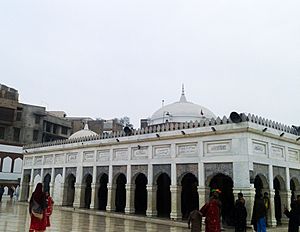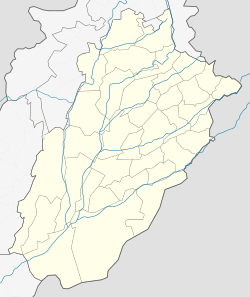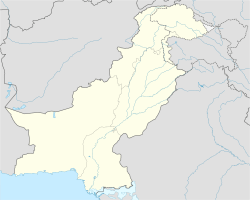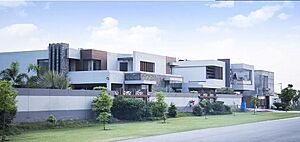Pakpattan facts for kids
Quick facts for kids
Pakpattan Sharif
پاکپتّن شریف
|
|
|---|---|
|
City
|
|

The highly-revered Shrine of Baba Farid is located in Pakpattan
|
|
|
Location in Punjab, Pakistan
|
|
| Country | |
| Province | |
| District | Pakpattan |
| Old Name | Ajodhan |
| Elevation | 156 m (512 ft) |
| Population
(2017)
|
|
| • City | 176,693 |
| • Rank | 48th, Pakistan |
| Demonym(s) | Pakpattni |
| Time zone | UTC+5 (PST) |
| Postal code |
57400
|
| Dialling code | 0457 |
Pakpattan is a city in the Punjab province of Pakistan. It is also known as Pākpattan Sharīf, which means "Noble Pakpattan." This city is the capital of the Pakpattan District.
Pakpattan is the 48th largest city in Pakistan by population, based on the 2017 census. It is a very important place for the Sufi Chisti order in Pakistan. Many people visit Pakpattan because of the Shrine of Baba Farid. He was a famous Punjabi poet and Sufi saint. About 2 million visitors come to the city each year for the annual urs fair, which honors Baba Farid.
Contents
- What's in a Name? The Etymology of Pakpattan
- A Glimpse into Pakpattan's Past
- Where is Pakpattan? Geography
- People of Pakpattan: Demographics
- Languages Spoken in Pakpattan
- A Sweet Treat: Famous Food
- Dhakki: The Old City Area
- The Revered Shrine of Baba Farid
- Other Important Shrines in Pakpattan
- See also
What's in a Name? The Etymology of Pakpattan
Before the 16th century, Pakpattan was called Ajodhan. The city's current name comes from two Punjabi words: Pak and Pattan. Pak means "pure," and Pattan means "dock" or "ferry."
This name refers to a ferry crossing the Sutlej River. This ferry was popular with pilgrims visiting the Shrine of Baba Farid. It also symbolized a journey of salvation, like crossing a river with the saint's help.
A Glimpse into Pakpattan's Past
Early History of Ajodhan
Pakpattan started as a village named Ajodhan. It was a key location for a ferry service across the Sutlej River. This made it an important stop on old trade routes between Multan and Delhi.
Because it was on flat land, Ajodhan was often attacked. Invasions from Central Asia began in the late 900s. The city was captured by different rulers over time, like Sebüktegin in 977–78 CE and Ibrahim Ghaznavi in 1079–80.
Medieval Times and Baba Farid's Influence
Turkish settlers also came to the area due to the expanding Mongol Empire. By the time Baba Farid arrived around 1195, Ajodhan already had a mosque and a Muslim community. Baba Farid moved to Ajodhan from his home village near Multan.
He set up a Jama Khana, a kind of religious center. Here, his followers would gather for spiritual lessons. This helped the region shift from being mainly Hindu to becoming more Muslim. Many people visited the shrine daily for blessings.
After Baba Farid's death in 1265, a shrine was built. It grew to include a mosque and other buildings. This shrine became one of the first important Islamic holy sites in South Asia. It made Pakpattan a major pilgrimage center in the Islamic world.
The Arab explorer Ibn Battuta visited the town in 1334. He paid his respects at the shrine. Later, Tamerlane visited the shrine in 1398. He prayed for strength and spared the town's people out of respect for Baba Farid.
Mughal Empire and Royal Support
The town continued to grow as Baba Farid's shrine became more famous. Its location on the Multan to Delhi trade route also helped. The shrine's importance grew so much that the town was renamed "Pakpattan."
The Mughal emperors supported the shrine. Emperor Shah Jahan gave royal support to the shrine's chief and Baba Farid's descendants in 1692. These descendants became known as the Chistis, a group of landowners. An army of followers from local clans protected the shrine and the Chistis.
Pakpattan's Independent State
After the Mughal Empire weakened, the shrine's chief created an independent state around Pakpattan. This state expanded its territory in 1757. The shrine's army even fought off an attack by the Sikh Nakai Misl state in 1776.
Sikh Rule and British Control
In 1810, Maharaja Ranjit Singh of the Sikh Empire took control of Pakpattan. This ended the shrine chief's political independence. However, Ranjit Singh still gave the shrine money and land. This helped him gain support as a non-Muslim ruler.
When the British took over Punjab in 1849, Pakpattan became a district headquarters. This changed a few times before settling in Sahiwal. The Pakpattan Municipal Council was set up in 1868.
Between the 1890s and 1920s, the British built many canals around Pakpattan. This led to new villages being formed. In the 1940s, Pakpattan became important for Muslim League politics. The shrine allowed the League to speak at the urs fair in 1945.
The Partition of 1947
Before the partition of 1947, many Hindus and Sikhs lived in Pakpattan. They were important in business and banking. When India and Pakistan were divided, many Hindus and Sikhs left Pakpattan. They moved to India, and Muslim families from India settled in Pakpattan.
Modern Pakpattan
The Partition changed Pakpattan's population a lot. Many Sikh and Hindu residents moved to India. More Chisti scholars and families settled in the city. This made Pakpattan even more important as a religious center.
The shrine's caretakers became very influential in local politics. Pakpattan's shrine grew in importance because it became harder for Pakistani Muslims to visit other Chisti shrines in India. Sikhs in India still remember Baba Farid's urs festival. Pakpattan remains a major pilgrimage site, drawing millions of visitors each year.
Where is Pakpattan? Geography
Pakpattan is about 205 kilometers (127 miles) from Multan. It is also about 40 kilometers (25 miles) from the border with India. By road, it is about 184 kilometers (114 miles) southwest of Lahore.
The district is surrounded by other districts. To the northwest is Sahiwal District. To the north is Okara District. The Sutlej River and Bahawalnagar District are to the southeast. To the southwest is Vehari District.
People of Pakpattan: Demographics
In 1998, the population of Pakpattan city was 109,033 people. By 2017, the population had grown to 176,693. This was a big increase of over 62% in just 19 years.
Languages Spoken in Pakpattan
Punjabi is the main language spoken by people in Pakpattan. However, Urdu is also widely understood and spoken. Some people also speak Haryanvi, which is also called Rangari. The Meo people have their own language called Mewati.
A Sweet Treat: Famous Food
Tosha is a special sweet that was first made in Pakpattan. It is also sold in India as a delicious treat that came from Pakpattan.
Dhakki: The Old City Area
Pakpattan's ancient Dhakki area is like a small hill or high place. This is where the city first began and then grew outwards. The Dhakki is thousands of years old and full of history.
It has narrow, winding streets. In the past, it had six large gates that closed at night. Only a few of these gates still stand today. The area also has a part of the "Kacha Burj" wall. This was a defensive fort built by Sher Shah Suri in 1541 to watch for invaders.
Before the 1947 partition, many Hindu families lived in the Dhakki. Some of their old houses are still there today. The famous Shrine of Baba Farid is also located in the Dhakki area.
The Revered Shrine of Baba Farid
The Shrine of Baba Farid is one of the most respected holy places in Pakistan. It was built in the town once known as Ajodhan. The shrine became so important that it overshadowed the old town. This led to the town being renamed "Pakpattan," meaning "Holy Ferry." This name refers to pilgrims crossing a river to reach the shrine.
The shrine has greatly shaped Pakpattan's economy and politics. It continues to be a central part of the city's identity.
Other Important Shrines in Pakpattan
- Darbar Hazrat Khawaja Aziz Makki Sarkar
- Khawaja Amoor ul Hasan
See also
 In Spanish: Pakpattan para niños
In Spanish: Pakpattan para niños




